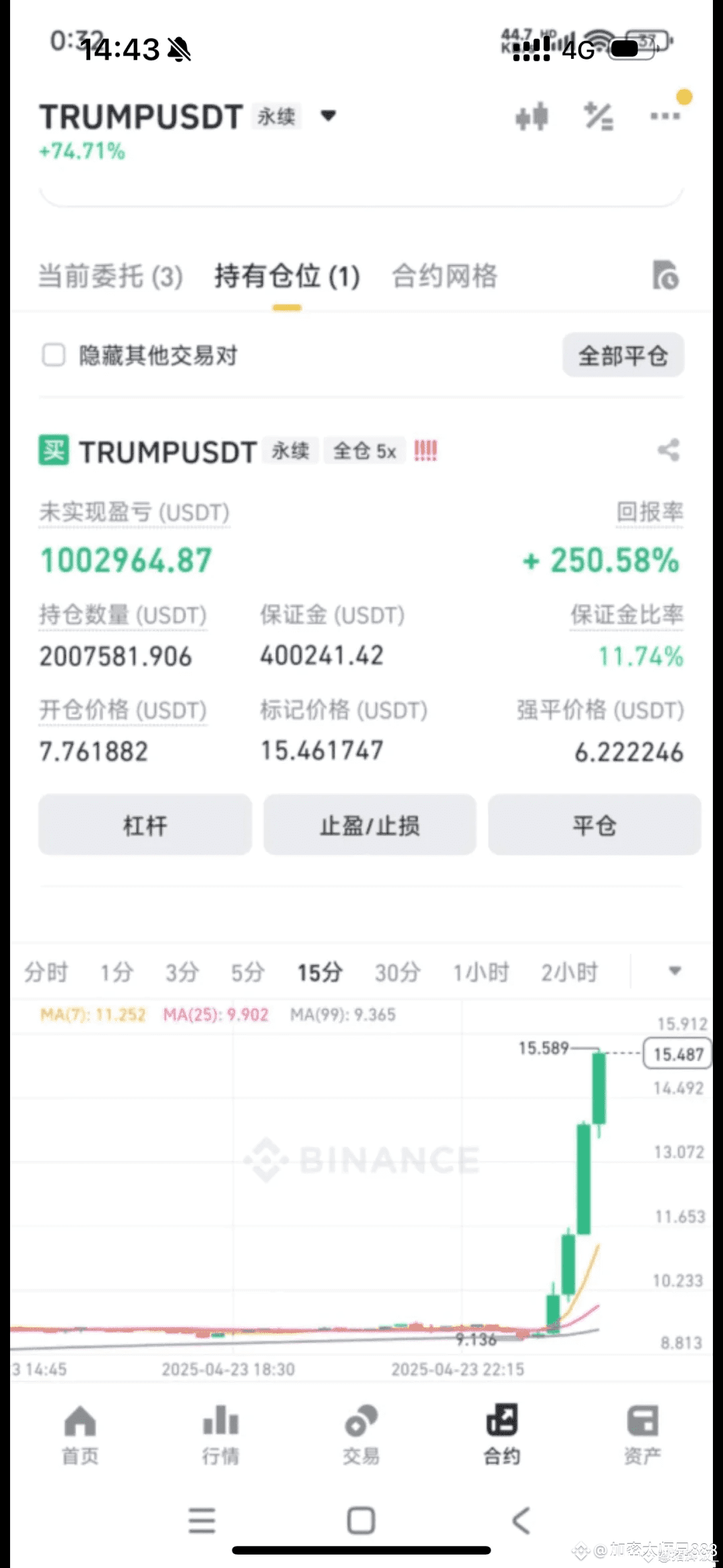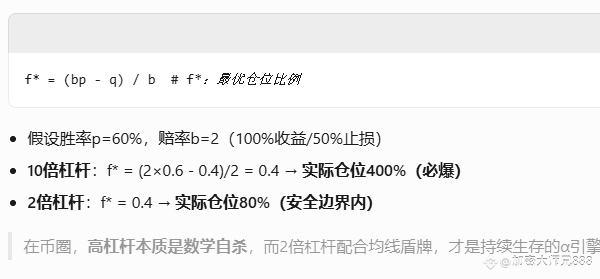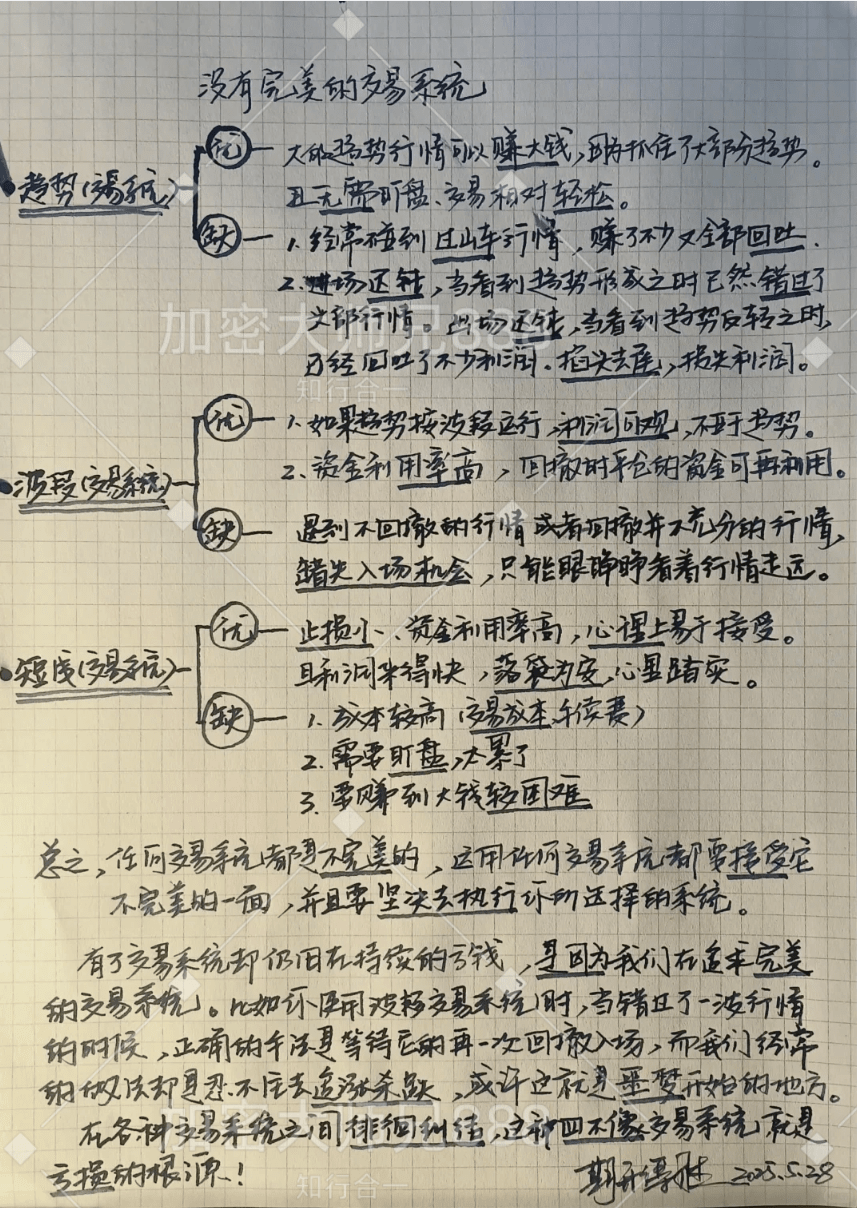Many crypto novices, even seasoned players, still do not understand the difference between high and low leverage, or think that high leverage is terrifying and the source of all evil, the reason for their liquidations. Moreover, many influencers simply repeat what others say, telling you not to use high leverage without mentioning position management, and they do not tell you that your liquidation and significant losses have nothing to do with leverage, but are directly related to your position. I have always traded with full leverage.
I encounter too many fans from the crypto circle every day. I find that basically 99% of people have not understood the logic behind this. Today, I will talk about a basic logic here, so that everyone understands that it is not the case that high leverage is the reason for your losses or liquidation, or has any relation at all. Many people just hear what others say, see that the leverage is so high, and get scared without thinking about the underlying principles themselves. To clarify this, let’s take an example:
For example, if Bitcoin is priced at 10,000 USD each and I open both 100x leverage and 2x leverage for one Bitcoin's contract with the same position, if the stop loss allows for a 200-point space, a fluctuation of 200 points results in a gain or loss of 200U, regardless of whether you use 100x or 2x leverage; the end result is the same. The amount of money gained or lost is also identical. Therefore, how many times leverage you use has no relation to how much you gain or lose.
What really matters is your position management and control. The role of leverage is to amplify your funds. For example, if Bitcoin is 10,000 USD each and I only have 100U, I need to use 100x leverage to open a contract for one Bitcoin. This is equivalent to trading at full margin and has nothing to do with leverage. If Bitcoin fluctuates by 100 points, you will still gain or lose 100U. This is prone to liquidation because you are trading at full margin. If I only have 100U and I still use 100x leverage but only open a position of 0.1 Bitcoin, I would need Bitcoin to fluctuate by 1000 points to trigger liquidation.
From another perspective, if you currently have 100U and you open 2x leverage, it means your 100U position is doubled, allowing you to open a maximum position of 200U. This means you can open 0.2 Bitcoin at most. If you only open 0.1 Bitcoin, you would need Bitcoin to fluctuate by 1000 points to trigger liquidation. From this, it is clear that with 100x leverage and 2x leverage, the same fluctuation results in identical gains and losses. Do you understand?
Actually, what I just mentioned is not that high leverage makes you prone to liquidation, but that your position makes you prone to liquidation. So, whether you are easily liquidated is directly related to your position. For example, if I have 10,000U and open 100x leverage but only hold a position of 0.1 Bitcoin? My position is very small, and although I used high leverage, in order for me to be liquidated, Bitcoin would need to fluctuate by 100,000 points. I would only be liquidated if Bitcoin drops by that much, and here, don’t say that I opened 100x leverage, even if I opened 10,000x leverage, but I only have 0.1 position, the gains and losses would still be the same, just like opening 2x leverage, there is no difference. This means that if I open multiple Bitcoin contracts, I do not have a liquidation price. Because Bitcoin is currently priced at 10,000 USD, it is impossible for it to fall by 100,000 points.

Using data models to dissect 90% of the deadly traps in contract trading.
Kelly Formula Verification:

1. Risk matrix quantitative comparison of two leverage modes
1. Margin resistance to volatility coefficient calculation
Opening 10x leverage with 1000U: Margin rate of 10%, when the underlying asset fluctuates by 1%, loss = 10000U×1%=100U, accounting for 10% of the margin (100/1000); when the fluctuation reaches 10%, it triggers the liquidation line (10000U×10%=1000U = total margin). The risk critical point corresponds to the fluctuation amplitude of one medium bearish candle on the 4-hour line (mainstream coins have daily fluctuations of 3%-5%).
Opening 2x leverage with 5000U: Margin rate of 50%, loss of 100U when fluctuating by 1%, but only accounts for 2% of the margin (100/5000); must fluctuate by 20% to trigger liquidation, equivalent to the extreme scenario of Bitcoin falling from 30,000 USD to 24,000 USD. Risk redundancy is 200% of the former.
2. Probability curve for capital survival
Backtesting Bitcoin's 48 days of single-day fluctuations over 5% in 2023:
Under 10x leverage mode, the probability of triggering liquidation reaches 83% (40/48)
Under 2x leverage mode, the probability of triggering liquidation is only 4% (2/48)
The survival curves of the two groups show a cliff-like differentiation after 15 fluctuations, with the high leverage group having a capital wipeout rate of 91%.
3. Mathematical model for operational error tolerance
Set the average reaction delay for beginners at 15 minutes (time to complete judgment - place order); the standard deviation of 15-minute fluctuations for mainstream coins is 0.8%:
Under 10x leverage, 2 consecutive reverse fluctuations can consume 16% of the margin, triggering psychological panic threshold
Under 2x leverage, 10 consecutive reverse fluctuations are needed to reach the same panic threshold
This explains why beginners with high leverage easily fall into a negative cycle of 'frequent liquidations - chasing highs and cutting losses'.
2. Technical protection system for novice contract trading
1. Golden formula for leverage selection
Safe leverage multiplier = (Maximum acceptable daily loss rate × Total capital) ÷ (Underlying asset 24-hour volatility × Position amount)
Example: With 10,000 U in capital, acceptable maximum loss in a single day is 5% (500U), holding 10,000 U, underlying asset 24-hour volatility is 5%
Safe leverage = (500U) ÷ (10000U×5%) = 1x
This formula reveals: The higher the volatility of the coin (such as altcoins with an average daily volatility of 10%+), the lower the safe leverage should be.
2. Technical parameter settings for dynamic stop loss
Short-term (15-minute chart): Stop loss = Opening price ± (ATR indicator ×2), ATR value reflects the recent average fluctuation amplitude
Medium-term (4-hour chart): Set stop-loss at 1% outside the recent 3 trading days' low/high points to filter out noise signals
3% warning line before forced liquidation: set automatic reduction instructions to avoid instant liquidation in extreme market conditions
3. Cognitive ladder of contracts and spot trading
The core of spot profits is 'trend continuation', while the core of contract profits is 'volatility acceleration'. Beginners need to complete three cognitive leaps:
Can achieve a monthly return of 5%+ for 6 consecutive months in spot trading (proving trend judgment ability)
Master the top and bottom signals of MACD divergence + volume verification (filter out false breakouts)
Establish a 'loss log': record the fluctuation trigger points and stop-loss response times for each trade
3. Technical architecture of mainstream coin trading system
1. Dynamic balance strategy for medium to long-term positions
Core Position (60%): Allocate Bitcoin (40%) + Ethereum (20%), reference indicator is MVRV ratio (Market Cap to Realized Market Cap Ratio); increase position when <1.2
Rolling capital (30%): When the price breaks above the 20-week line and the weekly RSI<60, use 10% of the position to add, reduce position by 5% when RSI > 70
Cash reserve (10%): For re-entering during extreme market conditions (Fear Index < 20), with a single re-entry not exceeding 5%
2. Temporal Node Model for Swing Trading
Entry signal: A 'volume bullish engulfing' appears on the daily level, and the 5-day line crosses above the 10-day line to form a golden cross
Exit Node:
First Take Profit Level: Previous High ×1.08 (Fibonacci 1.08 Extension)
Second Take Profit Level: Daily MACD histogram volume reduction of 30%+
Position control: Build position at 30% during breakthroughs, add 20% upon confirming pullbacks, and adjust the remaining 50% flexibly based on volume changes
3. Multi-dimensional verification of trend judgment
Lifeline System:
Short-term (4 hours): 20EMA acts as the trend continuation line; if the closing price falls below it for 3 consecutive K-lines, reduce position
Medium-term (daily): 50EMA acts as the bullish-bearish dividing line; increase position by 30% when crossing above, decrease to 30% when crossing below
Volume verification: Trading volume during an increase must maintain above 120% of the average over the past 5 days, otherwise it is considered a false trend
4. Reverse thinking algorithm for trading decisions
1. Risk entropy value calculation for surging markets
When the price increases by more than 15% in 24 hours and deviates from the 5-day line by more than 5%:
Risk entropy value = (Price increase ÷ Average volatility) × (Market capitalization ÷ 24h trading volume)
When entropy value > 8, trigger the reduction instruction (reduce position by 15% each time)
2. Opportunity coefficient model for market crashes
Opportunity coefficient = (Historical volatility ÷ Current volatility) × (Fear index ÷ 100)
When the coefficient > 1.5, start building positions in batches (increase position by 5% every time it drops by 3%)
When the coefficient < 0.8, even if the price drops, you need to wait and see (to avoid catching a falling knife)
3. Health indicators of capital curves
Maximum drawdown rate: Single drawdown not exceeding 15%, exceeding that pauses trading for 3 days
Profit continuity: After 3 consecutive losses, forcibly reduce position to 20%
Sharpe Ratio: Monthly return ÷ Monthly volatility > 1.2, otherwise optimize the strategy
The essence of trading is not predicting price points, but establishing a quantifiable response system. The core difference between opening 10x leverage with 1000U and 2x leverage with 5000U lies in understanding the formula: 'Risk exposure = Leverage × Volatility sensitivity × Reaction delay'. For 90% of beginners, before mastering trend capturing ability in spot trading, the leverage in the contract market should always be set to 1x - surviving through volatility cycles is the first principle of profit in the crypto circle.
If you currently feel helpless and confused in trading, and want to learn more about the crypto circle and get firsthand cutting-edge information, click on the profile picture to follow me, @加密大师兄888 to avoid getting lost.
Understanding market conditions gives you confidence in your operations. Consistently making profits is far more practical than fantasizing about getting rich quickly.
